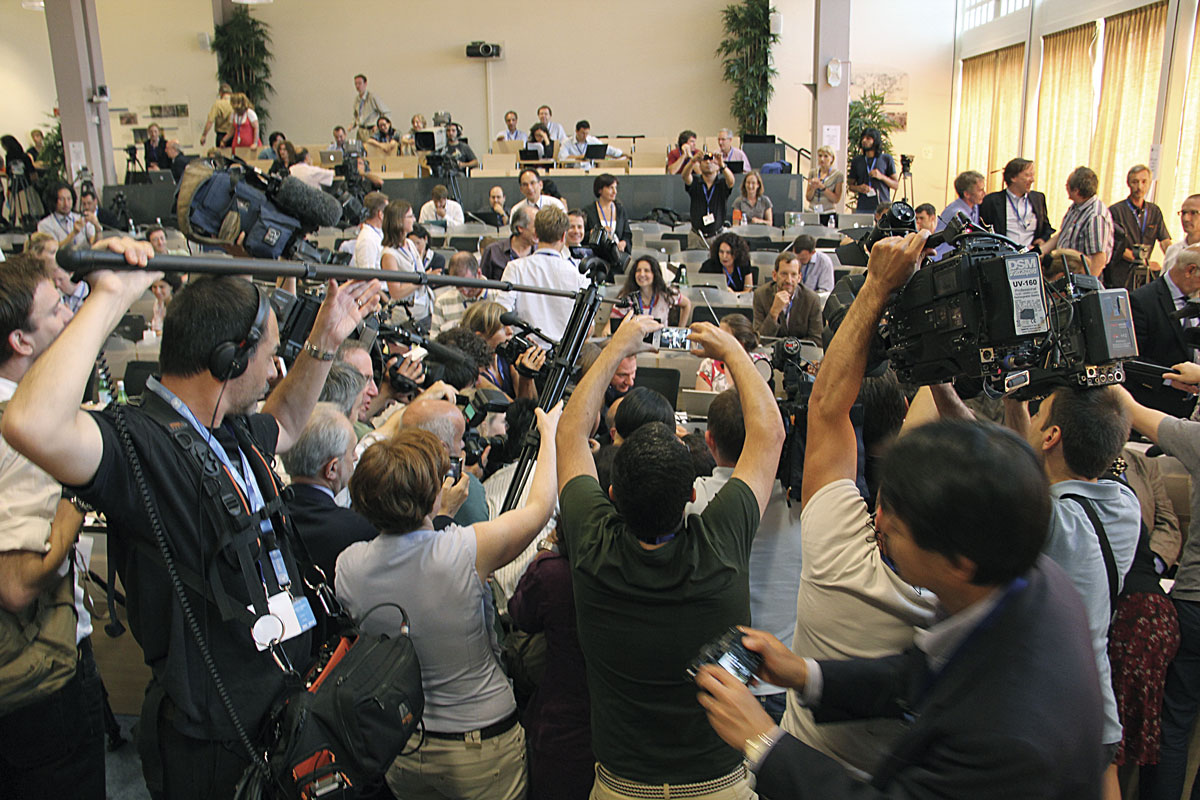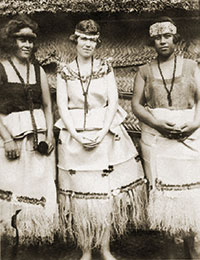What is scientific about social science?
The complexity of measuring human behavior

The social and behavioral sciences share many characteristics with the «hard» or «natural» sciences, including a commitment to the systematic analysis of empirical data, whether quantitative or qualitative. Yet the subject matter of social science is sometimes elusive, involving many abstract entities like values and cultures, and its methods do not always involve measurement or experimentation. Is social science «scientific» or is it not?
Keywords: social science, humanities, scientific method, participant observation.
On the surface of things, whether social science is «scientific» seems like an easy question. Like other scientists, social and behavioral scientists gather data, analyze and interpret it in the light of theory, and reach empirically driven conclusions that add to the cumulative body of human knowledge – in this case, knowledge about the nature of being human. Yet the question keeps arising anew, from policy makers among others. And there are new aspects to this question: In 2010, the American Anthropological Association stopped describing its activities as «science», stating on its current website that it embraces the scientific method but also draws from the humanities (American Anthropological Association, 2014). History, like anthropology, uses many of the same strategies as social sciences such as sociology and political science to learn about human society, yet is generally classified with the humanities in university curricula. Communication studies also combines elements of the social and behavioral sciences with insights from the humanities. And linguistics, the scientific study of the nature of human language, is regularly taught in departments of literature.
«Many aspects of “natural” science are also not based on rigorous experimentation»
Many factors muddy the divide between social scientific and humanistic study, as well as between the social sciences and the «natural» or «hard» sciences. These include the role of interpretation, the use of qualitative as well as quantitative methods, the role of scientific objectivity, and – ultimately – the ontological status of the conclusions reached. Social and behavior scientists use variables such as «attitudes» and abstract concepts such as «cultures» that are not physical objects that can be seen or touched – although they can certainly be measured and observed. And the inherently reflexive process of turning the lens of science on humanity itself may strike some observers as no more than subjective meditation. Some of the theories used in social science, especially the «big idea» theories famously characterized by sociologist Robert Merton as «grand» theories (1968), are difficult to definitively establish or refute. Even so, social science has many characteristics that clearly establish it as scientific, as well as some characteristics that might call this into question.
Social science methods
We usually understand the «hard» or «natural» sciences to consist of fields like chemistry, biology, or physics that study physical phenomena by using what is known as the scientific method. This is most commonly understood to mean the hypothetico-deductive method in which a hypothesis is derived from theory and then tested by collecting empirical data, typically in an experiment of some sort in which conditions deemed outside the scope of the test are eliminated or controlled as much as possible. One dictionary defines soft science, by contrast, «as sociology or anthropology, that deals with humans as its principle subject matter, and is therefore not generally considered to be based on rigorous experimentation» (Collins English Dictionary, n.d.). At least they define social science as science –of a sort. But this is a very problematic characterization.
First of all, if we stop and think about it, many aspects of «natural» science are also not based on rigorous experimentation. If we ask a diverse group of people what science consists of, a large share of them will be likely to mention experiments. Some likely will recall their early educational experiences where doing a science project meant exactly that – conducting some sort of an experiment. Yet this is a very narrow definition. All of the modern-day sciences actually sprang from observation as well as experimentation. In physics, early investigators observed things falling, yielding the theory of gravity. In biology, observations of the form and behavior of animals yielded taxonomic schemes and then, later on, complex theories about evolution and ecology. In geology and astronomy, even today, much of the work is based on observation and inference. We cannot directly experiment with the Earth’s core or the chemistry of distant stars, even though we can bring some related ideas into the laboratory for testing. We cannot even observe these places directly, but we use theories, models, and observation – aided by instrumentation – to understand them. New species, new strata, and new stars are not discovered primarily through experiments.

Like other scientists, social and behavioral scientists gather data, analyze and interpret it in the light of theory, and reach empirically driven conclusions that add to the cumulative body of human knowledge. Observing human social groups can be complex. In the picture, a group of people on a city street go about their lives. / Miguel Lorenzo
Of course, early science based on observation also gave us alchemy and astrology, which turned out to be scientifically wrong, but that does not mean observation is inherently «unscientific» or that it is unimportant as a scientific method, even today.
Human beings tend to be organized in groups: political parties, cultures and subcultures, religious and professional groups, hierarchical socioeconomic classes, families, clans, tribes, gangs, cliques, and clubs. Our social institutions, such as nations, churches, schools, legal and political systems, corporations and companies, reflect and perpetuate these groups. Sociologists, anthropologists, and political scientists who study these groups do so largely through observations of various kinds. Yes, experiments are also possible; psychologists who study individuals arguably make the widest use of experiments, but social psychologists who study groups often use experiments as well. Even so, not everything in social science can be brought into the laboratory, any more than everything in science can. Relying solely on experiments instead of observations is not a fair criterion for what sorts of things should be considered «scientific».
However, ask a dozen social scientists whether they feel they are being «objective» when they conduct their research, and you will likely get a dozen different answers. Some will say «yes, of course». Others are fully aware that objectively observing other human beings, especially in naturalistic conditions (that is, in their everyday lives) is difficult and may be impossible. The presence of the observer inevitably changes the observed. An ethologist (a scientist who studies animal behavior) has a fair shot at being able to see and record relevant data more or less directly – imagine a field worker with a clipboard, a checklist, and perhaps even a stopwatch parked on a savannah, or even sitting on a bench in front of a zoo’s baboon exhibit. But much of what defines and drives human behavior is internal and cannot always be directly observed, let alone directly measured. Talk is a powerful clue to this internal life; nevertheless, what people say (assuming the observer knows the language) is not the same as what they do – or what they are actually thinking.
«The presence of the observer inevitably changes the observed»
Some social scientists would not even claim that it is always desirable to maintain perfect objectivity, assuming this were even possible, while observing humans. The research method of participant observation, derived from cultural anthropology but now very widely used by other social scientists, rests on the assumption that to fully understand a human social setting, the researcher must be a part of that setting. They must be able to talk to people, to co-experience their lives to some degree. And yet they must remain to some extent an outsider. Move to a foreign country, and it takes a long time to «go native» and become an indistinguishable part of the new cultural scene. Maybe this will never even happen, or at least not completely. But the «outsider» living within a foreign culture has a unique vantage point. In some ways it may be easier to see what is unique about a culture not one’s own, than recognize cultural patterns that are more familiar.
Traditionally, the field work required of a cultural anthropology PhD student (at least in the US) required a full year living in the culture under study. Despite the perceived need for the researcher to become immersed in the group reflected in this requirement, the status of partial «outsider» is sometimes described as what allows the participant observer to see (and feel) what is unique and different about the setting being studied. In our own native culture, whatever it might be, we take so many things for granted – beliefs, customs, rituals, rules of etiquette, leadership patterns and group decision-making strategies; the division of the day into sleep, work, and play; the division of other people into friends and relatives, allies andenemies. To an outsider, such as a researcher who is trying to act as a participant rather than a fully «objective» observer, some of these elements may rise more clearly to consciousness.
Other social and behavioral scientists, those whose research is based on formal experiments as well as those who study abstract concepts like values, attitudes, or opinions outside of the laboratory with instruments such as surveys, are much more centrally concerned with measurement issues. Measurement is a difficult challenge in social and behavioral science, but whether it is more difficult than measuring the size, shape, «flavor» and «color» of a quark is a philosophical point. Social scientists do face unique measurement challenges, even so.
Three R’s: Reification, replication, and refutability

The research method of participant observation, derived from cultural anthropology but now very widely used by other social scientists, rests on the assumption that to fully understand a human social setting, the researcher must be a part of that setting. In the photograph, the anthropologist Margaret Mead between two Samoan women around 1926. / Library of Congress, EUA
The strength of the behaviorist tradition within twentieth century American psychology is commonly attributed to a reaction against the «unscientific» nature of psychoanalytic theory, as represented early on by the work of Sigmund Freud. Freud’s work was, of course, the main source of the idea that dreams represent unconscious mental processes and the assertion that their analysis in a therapeutic setting can be used to uncover the root cause of many psychological problems. This may well be true, but it is a scientifically problematic assertion. If we begin with the assumption that dreams always carry important meaning and can reveal something about the thoughts and desires that the individual has suppressed, then all dreams become subject to interpretation in these terms. Dreams that are not symbolically important in this way cannot readily be distinguished from those that are. The underlying proposition is never tested and does not even seem to be testable; it becomes a sort of self-fulfilling prophecy. In other words, it is not – in this respect – «scientific».
In reaction, and in a conscious attempt to make the field more «scientific», researchers in the behaviorist tradition once tried to avoid consideration of any variables that could not be directly observed. Longer term, this did not hold up well, given that human beings are routinely motivated by thoughts and feelings that cannot be directly observed, and studying the behaviors that result does not consistently reveal what those motivating thoughts and feelings might actually have been. Even so, the turn away from the perceived subjectivity of the psychoanalytic approach resulted in an ongoing emphasis on accurate quantitative measurement of variables, even latent or «invisible» ones, among many researchers in psychology and related fields. Here the use of replicability as a test of validity – a concept originally foreign to cultural anthropology – is more the norm. This is not to say that anthropologists do not concern themselves with validity, only that replicating statistical results based on measurement is not usually a central goal.
However, there are certainly problems in trying to measure invisible variables such as personality traits, values and beliefs, feelings and emotions, or internal thought processes in a replicable, systematic, way. It is conceivable (at least as a thought experiment) that we will someday be able to map some or all of these elements onto particular chemical or electrical features of neurons in the brain. Then we will have physical traces to measure, presumably with instrumentation of some sort, against which we can test our social or psychological theories more directly. Of course, some relevant items (including the physiological manifestations of emotions like fear or sensations like pain – sweating, for example, or an increased heart rate) can already be measured in an accurate, «scientific», way. But everything of interest to social scientists cannot presently be measured in terms of physical properties, and it seems likely this will always be the case.
«Social scientists do face unique measurement challenges»
Meanwhile, if we want to know what someone is feeling in response to a situation or other stimulus, we have to ask them. For example, let us just suppose that we want to study whether people with different personality characteristics are more or less likely to feel certain negative emotions in response to an experience. We will probably need to assess both the independent variables (personality characteristics) and the dependent ones (negative emotions) by asking questions. Social and behavioral scientists have developed many clever ways of asking these questions in careful, sometimes indirect, ways that can yield reliable quantitative data that are more sophisticated than simple self-reports of internal states. But this still does not seem as direct as, say, using a ruler to measure length. Indeed, in many situations, it is all too easy for researchers’ questions to be off the mark.
Complicating things further is that human thought and behavior results from a complex mix of learning, experience, and genetics. The nature-nurture debate is alive and well. Some human behavior such as the desire to be part of a group, fear of snakes or heights, or sexual attraction may have genetic components, but also has learned components. Some complex psychiatric disorders like schizophrenia appear to be partially hereditary, but are also influenced by experience. We are unlikely ever to find a single «gay gene» or «obesity gene» or even a «schizophrenia gene». But even if we did, the influence of environment and experience are inevitably intertwined with how genes are expressed. This complexity adds to the challenge of conceptualization and measurement: In any given case, are we measuring a stable biological tendency or characteristic, or the result of experience, which we imagine might be more malleable? For human beings, the most likely answer is often «both».

Human thought and behavior results from a complex mix of learning, experience, and genetics. The nature-nurture debate is alive and well; some human behavior such as the desire to be part of a group, fear of snakes or heights, or sexual attraction may have genetic components, but also has learned components. / Krappweis
Other complications arise in survey-based studies of attitudes and opinions. Of course, such surveys are not generally completed under controlled laboratory conditions. For example, we often do not know whether the person answering was concentrating on the task or just choosing answers at random. Although we can build in some clever checks for that as well, we also do not know whether the person is being honest. In the case of a mail or email survey, the person who actually fills it out may not be the one we intended it to reach. Of even greater importance, very small changes in the wording of questions on surveys can create fairly large differences in the percentage of people answering those questions in certain ways. Further, the patterns of those differences are not always obvious or well understood, so they are difficult or impossible to completely account for when designing questions or comparing results from different surveys.
This is often the explanation of differing results obtained when measuring attitudes toward a particular object (let us say nuclear power plants, for example). An attitude, by definition, is supposed to be a stable trait; if people have a particular attitude toward nuclear power plants, whether positive or negative, this should be fairly consistent over time and it will likely prove difficult to change. Opinions are assessed with respect to more specific situations (such as whether we should build a certain kind of nuclear facility in a certain location), but are assumed to depend on underlying attitudes that are more stable. More than one attitude may be involved, however, alongside values. For example, attitudes toward government can matter here; people may not trust the regulatory system. And environmental values also come into play. Understanding why people have certain opinions is amazingly complex.
In addition, different surveys often show huge differences in both attitudes and opinions in similar populations. In addition to question wording, the historical context matters as well. Are we in a situation of energy shortages, rising costs for electricity, or increased concern about global warming? Was there a major nuclear accident just a short time ago? In a changing context, our answers to general attitude questions, as well as our specific opinions, might shift as well. This too is not always predictable.
«Understanding “why” people have certain opinions is amazingly complex»
As a result, even though our measurement devices (questionnaire items used in an experiment or survey) might have been thoroughly tested ahead of time, the data obtained are always subject to interpretation. We may not always be measuring what we think we are measuring, no matter how careful our experimental or survey design. Our survey measurements today might not be comparable to our measurements ten years ago because the historical context has shifted, even if the question wording is identical (Bishop, 2005). Under these circumstances, our most highly quantitative, measurement-based areas of the social and behavioral sciences suddenly do not seem so very «scientific», after all.
Finally, cultural and linguistic variation is also important to such studies. If we ask the same question in six different languages, does it really mean the same thing to the people reading and replying in those different languages? Elaborate procedures for translation followed by back-translation are used to rule out important mistakes, but the nuances of expression in each language – and each culture – will still be different.
Social scientists are sometimes criticized for «reifying» measurement results. To «reify» is to treat as real. Are the values, attitudes, and opinions, as well as the personality traits, emotions, and thought patterns, that we study actually real objects? How can we tell – how do we even begin to think about this question? Do our methods and measurements assume that these are consistent and uniquely identifiable elements, when actually they may be much more inconsistent and difficult to pin down than social scientists typically recognize? Could they simply be products of our imagination? Just because an experiment has been successfully replicated, does that mean it proves what we think it means? Measurement reliability and validity are certainly issues in the «hard» sciences as well, but in the social sciences, these are particular challenges. Given these challenges, social science results may not always be generalizable in a statistical sense, but if – as we always hope – they generate deeper understandings, then these deeper understandings should extend beyond the case in question.
«Measurement reliability and validity in the social sciences are particular challenges»
Yet a strong argument can be made that social science is, after all, quite scientific. It is simply a form of science that deals with a very difficult subject matter. In science, we cannot always identify the function of every gene or predict which genes, working in concert with other genes, will produce a particular effect in a particular individual organism existing in a particular environment. This does not mean that genetics is not a science. It only means that genetics deals with a very complex topic. Meteorologists cannot always predict the weather and geologists cannot predict specific earthquakes with accuracy. Complex systems are difficult to characterize, and human beings and their social organization constitute one of the most complex systems around.
Communication research is the newest social science, and science communication research is the newest specialty in this area. This subfield is of special interest to this journal, which concerns itself with the communication of science. Science communication practice involves art as well as science, and therefore (like anthropology) draws from the humanities as well as the social sciences. So does science communication research, on occasion.
In the end, whether social science is actually «scientific» depends on what definition we use. Careful, systematic attempts at gathering empirical data, whether quantitative or qualitative, which are informed by theory and designed to add to our cumulative knowledge of human cognition, emotion, and behavior are still very «scientific», even though this pursuit does not always yield firm answers capable of fully predicting or explaining human behavior. This is true in part because that which we study is a constantly moving target.
REFERENCES
American Anthropological Association, 2014. «AAA Responds to Public Controversy over Science in Anthropology». American Anthropological Association. Arlington, Virginia. Retrieved on-line 30 July 2014. Available at: <http://www.aaanet.org/issues/press/AAA-responds-to-public-controversy-over-science-in-anthropology.cfm>.
Bishop, G. F., 2005. The Illusion of Public Opinion: Fact and Artifact in American Public Opinion Polls. Rowman and Littlefield. Lanham, Maryland.
Collins English Dictionary, s.d. «Soft Science». Collins English Dictionary – Complete & Unabridged 10th Edition. Harper Collins Publisher. Hammersmith, London. Retrieved on-line 30 July 2014. Available at: <http://dictionary.reference.com/browse/soft science>.
Merton, R. K., 1968. Social Theory and Social Structure. Free Press. Nova York.





